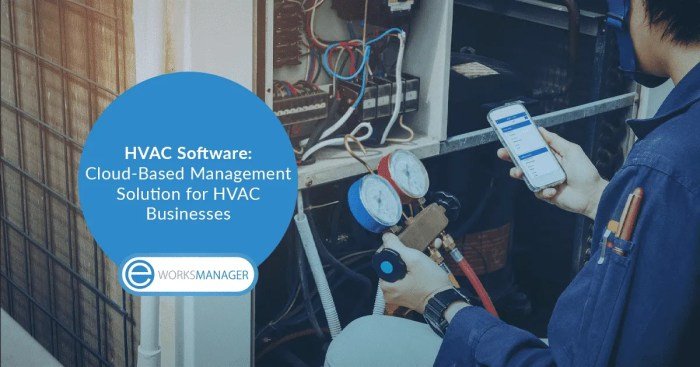In the realm of building management, HVAC systems play a pivotal role in maintaining comfort, productivity, and energy efficiency. With the advent of cloud-based technologies, HVAC software has evolved dramatically, offering a plethora of advantages that can revolutionize the way you manage your HVAC systems.
This comprehensive guide will delve into the intricacies of cloud-based HVAC software, exploring its benefits, features, and capabilities. We will uncover how cloud technology empowers HVAC systems with enhanced data management, remote monitoring, and seamless integration with other building systems, enabling you to optimize efficiency, reduce costs, and improve occupant comfort.
Cloud-Based Features
Cloud-based HVAC software offers numerous advantages over traditional on-premises solutions. By leveraging the power of the cloud, HVAC professionals can access their software and data from anywhere with an internet connection, improving efficiency, collaboration, and remote management capabilities.
Some of the key benefits of cloud-based HVAC software include:
- Accessibility: Access your software and data from any device with an internet connection, enabling remote monitoring and control of HVAC systems.
- Collaboration: Share data and collaborate with colleagues in real-time, regardless of their location, improving communication and decision-making.
- Scalability: Easily scale your software to meet the changing needs of your business, without the need for expensive hardware upgrades.
- Cost-effectiveness: Cloud-based software eliminates the need for costly hardware and IT maintenance, reducing operating expenses.
Security Considerations
While cloud-based HVAC software offers many advantages, it’s important to consider the security implications of storing sensitive data in the cloud. To ensure the security of your data, choose a provider that employs robust security measures, including:
- Encryption: All data should be encrypted both at rest and in transit to protect it from unauthorized access.
- Authentication: Strong authentication mechanisms, such as multi-factor authentication, should be used to prevent unauthorized access to your account.
- Regular security updates: The software provider should regularly update its security measures to address emerging threats.
Data Management and Analytics

Cloud-based HVAC software enhances data management by centralizing all system data in a secure and accessible cloud platform. This eliminates the need for manual data entry and consolidation, reducing errors and improving data accuracy.Analytics capabilities within the software allow users to analyze vast amounts of data to identify trends, patterns, and areas for optimization.
By leveraging machine learning algorithms, the software can automatically detect anomalies, predict failures, and generate actionable insights.
Data-Driven Decision-Making
Data collected by the software can be used to make informed decisions about HVAC system operations and maintenance. For instance, by analyzing energy consumption data, facility managers can identify areas where energy efficiency can be improved. Historical data can be used to predict future system performance, enabling proactive maintenance and reducing the risk of costly breakdowns.
“Data analytics in HVAC systems empowers facility managers with actionable insights to optimize system performance, reduce energy consumption, and enhance occupant comfort.”
Remote Monitoring and Control
Remote monitoring and control capabilities in cloud-based HVAC software empower facility managers to monitor and control HVAC systems from anywhere with an internet connection. This feature offers numerous benefits, including:
- Enhanced operational efficiency: Remote monitoring allows facility managers to quickly identify and address issues before they escalate, minimizing downtime and optimizing system performance.
- Reduced energy consumption: Cloud-based software enables data analysis and reporting, helping facility managers identify areas for energy optimization and implement strategies to reduce consumption.
- Improved occupant comfort: Remote monitoring allows facility managers to adjust temperature and humidity levels remotely, ensuring optimal comfort for occupants.
Cloud-based HVAC software typically provides remote access through a web-based interface or mobile application. This allows facility managers to:
- Monitor system performance in real-time
- Receive alerts and notifications of potential issues
- Adjust setpoints and control settings remotely
For example, a facility manager responsible for a large office building can use remote monitoring and control to identify a malfunctioning thermostat that is causing discomfort for occupants. By remotely adjusting the thermostat settings, the facility manager can resolve the issue quickly and efficiently, minimizing disruption to occupants.
Integration with Other Systems
Cloud-based HVAC software can integrate with various building systems to enhance efficiency and reduce costs. Integration enables seamless communication and data exchange between HVAC systems and other building components, optimizing overall building performance.
Integrating HVAC software with lighting systems, for example, allows for automated adjustments based on occupancy and daylight availability. This integration can significantly reduce energy consumption by dimming or turning off lights when spaces are unoccupied or have sufficient natural light.
Security Systems
Integrating HVAC software with security systems provides enhanced security and access control. Remote monitoring of HVAC systems allows for real-time surveillance, granting authorized personnel remote access to adjust settings or respond to alarms. This integration ensures the security of both the HVAC system and the building it serves.
Mobile Accessibility
Mobile accessibility for HVAC software offers numerous advantages, enhancing convenience and efficiency in HVAC system management.
Benefits of Mobile Accessibility
- Remote monitoring and control: Mobile apps allow users to monitor and control their HVAC systems remotely, enabling them to make adjustments and respond to alerts from anywhere with an internet connection.
- Improved convenience: Mobile accessibility provides users with the flexibility to manage their HVAC systems on the go, without the need to be physically present at the location.
- Enhanced efficiency: Mobile apps can streamline maintenance tasks, allowing users to quickly access system data, schedule appointments, and receive notifications about potential issues, reducing downtime and improving overall system performance.
Customization and Scalability
Cloud-based HVAC software can be customized to meet the specific needs of each business or organization. For example, businesses can add or remove modules to tailor the software to their specific requirements. They can also customize the user interface to match their branding and preferences.
Additionally, cloud-based HVAC software is highly scalable, meaning it can be easily expanded to accommodate the needs of a growing business.
Examples of Customization and Scaling
- A small business with a single location can use a basic cloud-based HVAC software package to manage their heating and cooling systems. As the business grows and adds more locations, they can easily scale the software to accommodate their growing needs.
- A large enterprise with multiple locations can use a more comprehensive cloud-based HVAC software package to manage their entire HVAC system. They can customize the software to meet their specific needs, such as adding modules for energy management or remote monitoring.
Cost and ROI

Cloud-based HVAC software offers various pricing models, such as subscription-based or pay-as-you-go options. The cost may vary depending on the features, number of users, and level of support required.Investing in cloud-based HVAC software can provide a positive ROI through cost savings and improved efficiency.
By centralizing data, reducing manual tasks, and optimizing energy consumption, HVAC software can help businesses save money and improve their bottom line.
Examples of Cost Savings and Efficiency Improvements
Reduced maintenance costs
Cloud-based HVAC software provides real-time monitoring and alerts, enabling proactive maintenance and preventing costly breakdowns.
Energy savings
By optimizing HVAC systems, cloud-based software can reduce energy consumption and lower utility bills.
Improved productivity
Automated tasks and remote access features free up technicians’ time, allowing them to focus on more value-added activities.
Increased revenue
By improving the efficiency and reliability of HVAC systems, businesses can increase tenant satisfaction and attract new customers.
Case Studies and Success Stories
Cloud-based HVAC software has proven its effectiveness in improving the efficiency, reducing costs, and enhancing the comfort of various businesses. Let’s delve into case studies and success stories that demonstrate the transformative power of this technology.
Case Study: Reduced Energy Consumption and Costs
A large office building in New York City implemented cloud-based HVAC software. By analyzing real-time data, the software identified inefficiencies in the system and optimized settings accordingly. As a result, the building experienced a significant reduction in energy consumption, leading to substantial cost savings.
Success Story: Enhanced Comfort and Productivity
A manufacturing facility in California faced challenges with maintaining a comfortable work environment for employees. After deploying cloud-based HVAC software, the facility gained remote monitoring capabilities, allowing them to adjust temperature and humidity levels in real-time. This resulted in improved comfort levels for employees, leading to increased productivity.
Lessons Learned
These case studies highlight the importance of data analysis and remote monitoring capabilities provided by cloud-based HVAC software. By leveraging these features, businesses can:
- Identify inefficiencies and optimize system performance
- Make data-driven decisions to improve comfort levels
- Gain remote access and control, ensuring prompt adjustments
Last Word
Embracing cloud-based HVAC software is a transformative step towards achieving optimal HVAC performance. By leveraging the power of cloud technology, you can gain unprecedented insights into your HVAC systems, automate tasks, reduce downtime, and enhance occupant satisfaction. As the industry continues to evolve, cloud-based HVAC software will undoubtedly remain at the forefront, empowering building managers with the tools they need to create smarter, more efficient, and sustainable buildings.
FAQ Corner
What are the primary advantages of cloud-based HVAC software?
Cloud-based HVAC software offers numerous advantages, including improved data management, remote monitoring and control capabilities, seamless integration with other building systems, mobile accessibility, customization and scalability, cost-effectiveness, and a positive return on investment.
How does cloud-based HVAC software enhance data management?
Cloud-based HVAC software provides centralized data storage and analytics capabilities, enabling you to collect, store, and analyze large volumes of data from your HVAC systems. This data can be used to identify trends, optimize system performance, and make informed decisions.
What are the benefits of remote monitoring and control capabilities in cloud-based HVAC software?
Remote monitoring and control capabilities allow you to access and manage your HVAC systems from anywhere with an internet connection. This enables you to respond quickly to system issues, adjust settings remotely, and ensure optimal performance even when you’re not on-site.
How can cloud-based HVAC software be integrated with other building systems?
Cloud-based HVAC software can be integrated with other building systems, such as lighting, security, and fire safety systems. This integration allows for centralized control and optimization of all building systems, resulting in improved efficiency, reduced costs, and enhanced occupant comfort.
What are the benefits of mobile accessibility in cloud-based HVAC software?
Mobile accessibility allows you to manage your HVAC systems using a smartphone or tablet. This provides you with the convenience of accessing system information, adjusting settings, and receiving alerts on the go, ensuring prompt response to any issues.